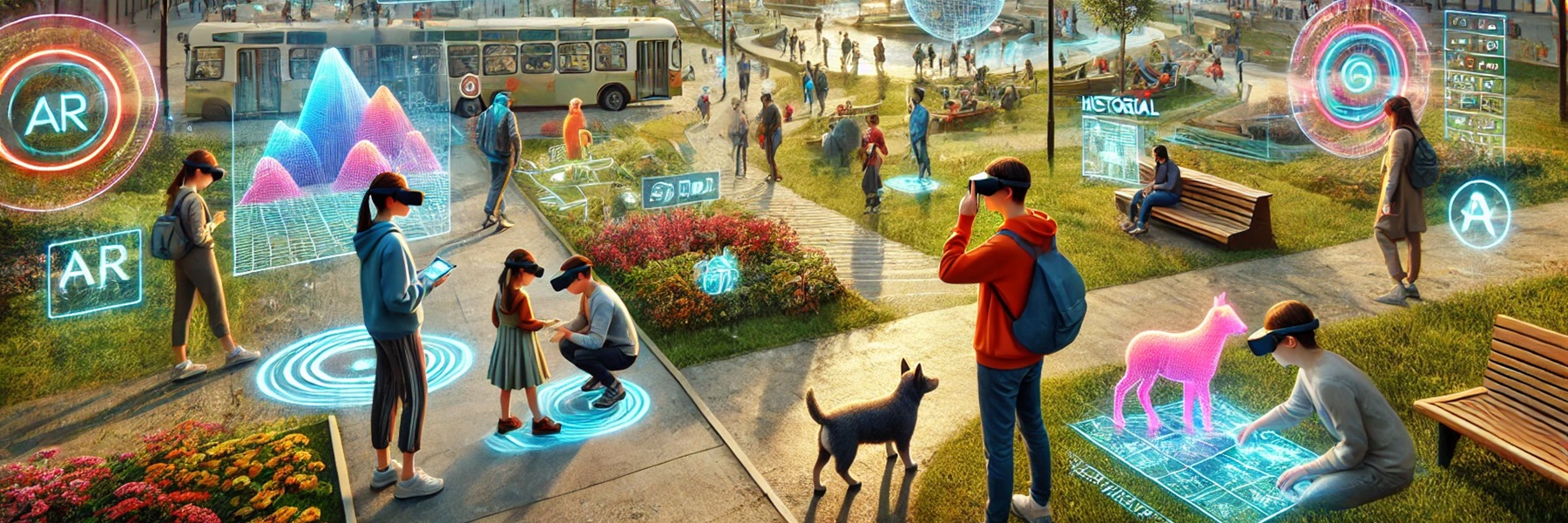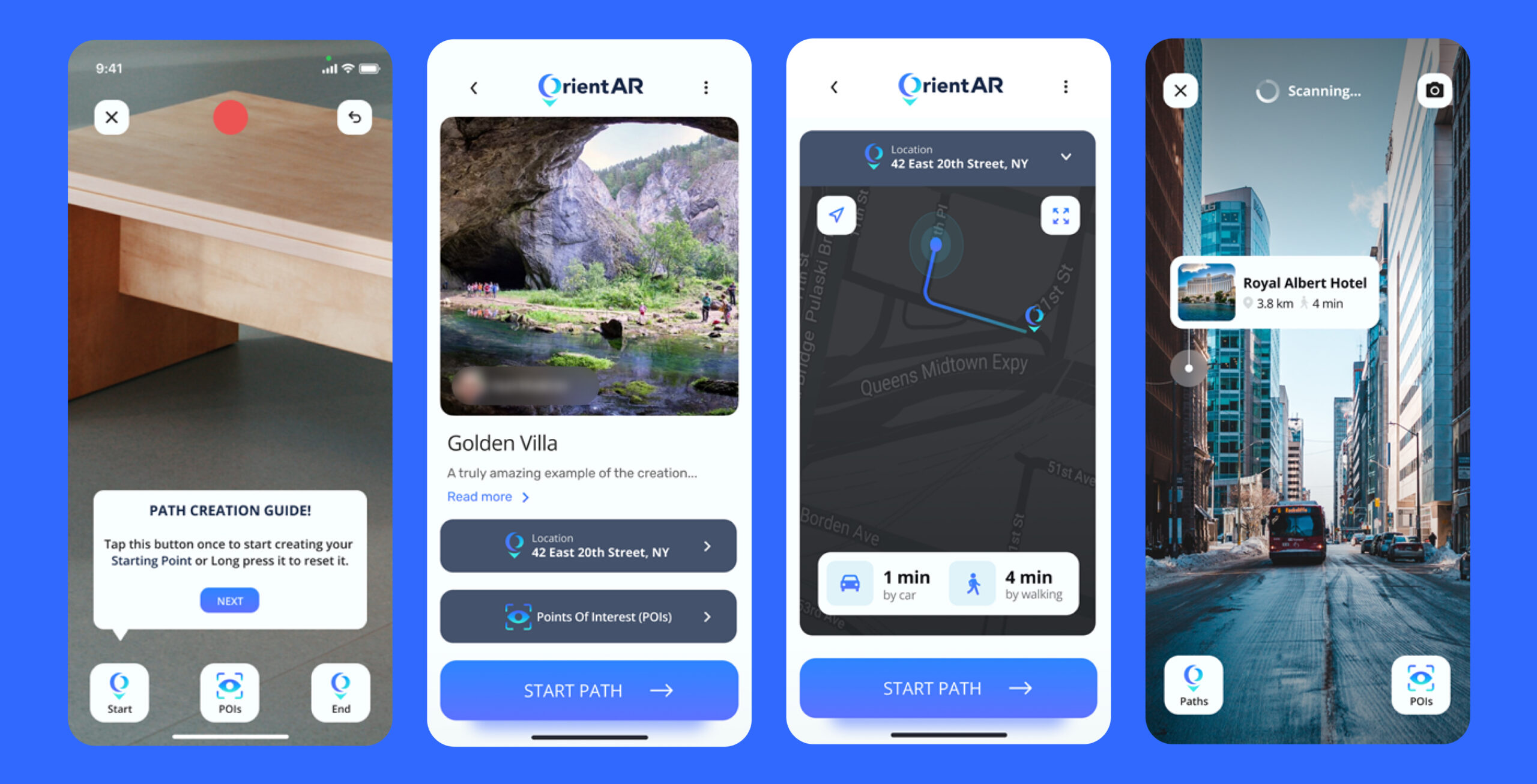Augmented Reality (AR) is a technology that allows virtual objects and information to be added on top of the real world. Unlike virtual reality (VR), where the user is fully immersed in a virtual environment, AR complements the real world by enriching it with additional elements.
What is the essence of AR?
The principle of AR is based on the use of cameras, sensors, and other devices to perceive the real environment and superimpose virtual objects or information on it. Popular examples of augmented reality include games where virtual characters can interact with real-world objects, augmented learning applications that allow you to see the internal structures of objects, and marketing applications that use AR to create interactive advertising campaigns.
Augmented reality has a wide range of applications in various industries, including gaming, education, medicine, construction, advertising, and many others. Recently, AR technologies have become increasingly accessible due to the development of mobile devices and specialized headsets, which contributes to their wider distribution and use.
A new era of navigation
One of the most interesting applications of augmented reality technologies is their implementation for various types of navigation, both outdoors and indoors. Such solutions represent a significant advancement compared, for example, to traditional maps. The AR component allows for expanding boundaries and providing users not only with the route they should follow but also with various hints, content, visual enhancements, and more.
Pin Finds app with AR navigation and content attached, developed by IT-Dimension
In our experience, we had various projects and experiments on developing AR-based mobile solutions with navigation features. For such applications, it was necessary to achieve not only accurate tracking of the location and alignment of virtual objects – but also to add attractive graphics in real-time without any time delays.
Several challenges that the development of augmented reality navigation can bring:
- Technology complexity: Working with AR requires an understanding of the specifics of working with marker tracking, image processing and a deep understanding of virtual and augmented reality technologies.
- Data processing: To accurately determine the user’s location and orientation in space, large amounts of data need to be processed using various sensors such as a camera, GPS, accelerometer, gyroscope, and magnetometer. Processing and synchronizing this data can be complex and requires optimization to minimize delays and errors.
- Availability of mapping data: To create in-building navigation applications, it is necessary to have access to reliable data on building structure, object locations, and other reference information. Obtaining and processing this data can be challenging, especially if the building is large or has complex architecture.
- Performance optimization: AR applications can consume a large amount of device resources such as CPU, memory, and battery. It is important to optimize the application to use resources efficiently and minimize the impact on device performance.
- User interface: Creating an intuitive and user-friendly interface to interact with augmented reality can be a challenge. You need to consider device limitations, touchscreen, and make sure the user experience is clear for those who interact with AR for the first time.
However, the result is worth it, because the use cases of AR navigation really excite:
- City navigation: with hints, content, and routes attached directly to the real-world objects;
- Malls, entertainment centers, exhibitions, museums: for more easier navigation in large buildings, as well as for expanded experiences with content and descriptions attached to physical places or objects;
- Advertising and promotion: attract new customers/buyers/visitors when they pass nearby and simply point their smartphone camera, for example, at your store;
… and many other applications that your imagination can come up with.
OritentAR app with indoor and outdoor navigation, plus own path building features, developed by IT-Dimension
Augmented Reality in E-Commerce
In today’s digital shopping landscape, customers often demand a more immersive experience to visualize products in their own spaces. Augmented Reality (AR) offers a solution, allowing users to virtually place a 3D rendering of an item like furniture in their environment using their smartphone camera. This technology provides valuable insights into how a product will fit or look, enhancing the online shopping experience. Given the increasing shift to online retail, AR experiences have become increasingly appealing, offering a new dimension to the shopping process.
A bit of statistics gotten from the Shopify Plus case study made by fashion brand Rebecca Minkoff:
- Shoppers are 44% more likely to add an item to their cart after interacting with it in 3D;
- Customers are 27% more likely to place an order after interacting with a product in 3D;
- Visitors are 65% more likely to place an order after interacting with a product in AR.
A great example of AR implementation in the online shopping process is our developed AR Furniture application. This solution serves as a catalog of furniture products, each of which can be virtually placed in one’s space using a smartphone camera.
Where to start if you are a customer who think about AR app development
Implementing an augmented reality (AR) project involves several key steps. Here’s a general outline to start with and use throughout the active development, testing, and release cycle:
- Define goals and requirements: The first step is to define the goals of your AR project and its functional requirements. What problem do you want to solve with AR? What features and functions should be included in the application? What is the target audience?
- Market and competitor research: Conduct market research to understand what AR apps already exist in your field and what features they offer. This will help you identify your competitive advantages and unique features.
- Platform and technology selection: Determine which platforms you want your app to run on (e.g. iOS, Android, etc.) and which AR technologies you plan to use (e.g. ARKit, ARCore, Vuforia, Unity3D, etc.).
- User Interface (UI) and User Experience (UX) design: Get an intuitive and user-friendly UI design. Consider different ways to interact with AR elements.
- Development and testing: Start developing the app using the chosen technologies and platforms. This includes creating 3D models, programming app logic, integrating device sensors and cameras, and testing the app on different devices and usage conditions.
- Iterative improvement: After completing the first version of the app, gather feedback from users and analyze it to determine what aspects of the app can be improved. Conduct regular updates and iterations to make your app even more useful and user-friendly.
- Launch and marketing: Once the app development is complete, prepare it for launch on the selected platforms. Develop your marketing strategy to reach new users through social media, advertising campaigns and partnerships with advertising venues.
- Support and update: After the app is launched, continue to support and update the app to respond to user feedback, fix bugs, and add new features and functionality.
Augmented Reality Market: Don’t Miss Your Place
According to an estimate from IndustryARC, the augmented and virtual reality market is estimated to grow to $140.1 billion by 2026, with a compound annual growth rate of 38.4% between 2021 and 2026. More than half of the market should be allocated to mobile platforms and cross-platform solutions.
By 2029, the market volume is estimated to be almost twice as large — 250 billion dollars. Analysts estimate the full disclosure of the possibilities and technical potential of augmented reality in the next decade.
The first peak of the fast-growing popularity of augmented reality came during the coronavirus pandemic when many retail sites suffered significant losses due to the lack of opportunity to demonstrate goods in person. But to counterbalance this, new opportunities to engage customers without the need to be physically present began to develop rapidly.
Another popular area to navigate will be the travel industry, where many Asian countries have already started to rapidly gain market share. China and Taiwan have already started to implement promising developments in augmented reality devices, and who knows, maybe your idea embodied in an application developed by our team will attract the attention of their investors.
At IT-Dimension, we offer a wide range of IT development services, utilizing AR and VR technologies. Whether it’s games, social apps, online stores, or navigation solutions, we cover it all. By discussing your idea, we can propose a development plan and select the optimal technology stack tailored to your budget and the required set of features.
Sources and links:
https://www.linkedin.com/pulse/augmented-reality-virtual-market-forecast2024-2030-aamira-begum-i9i9c
https://www.mordorintelligence.com/ru/industry-reports/augmented-reality-market
https://www.marketsandmarkets.com/Market-Reports/ar-vr-software-market-186416119.html?gad_source=1&gclid=Cj0KCQjwwYSwBhDcARIsAOyL0fg4LGQOIioTZqHUU4rUKeURKc—Itqbsb6jShwT93zj5sCpLzPcQoaApIcEALw_wcB
https://www.shopify.com/ng/blog/ar-shopping












